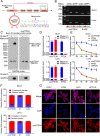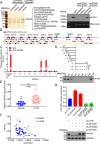circPTEN1, a circular RNA generated from PTEN, suppresses cancer progression through inhibition of TGF-β/Smad signaling
- PMID: 35135542
- PMCID: PMC8822707
- DOI: 10.1186/s12943-022-01495-y
circPTEN1, a circular RNA generated from PTEN, suppresses cancer progression through inhibition of TGF-β/Smad signaling
Abstract
Background: PTEN is one of the most frequently mutated genes in human cancer. Although the roles of canonical PTEN protein and PTEN isoforms have been extensively explored, the current understanding of PTEN family members cannot fully illustrate the diversity of their roles in biological processes and tumor development. Notably, the function of noncoding RNAs arising from PTEN has been less elucidated.
Methods: We searched circBase and circInteractome to analyze the potential of PTEN for generating circRNAs. Then, Sanger sequencing, RNase R and Actinomycin D assays were used to verify the ring structure of circPTEN1. In situ hybridization and qRT-PCR were used to determine the level of circPTEN1 in peritumor and tumor tissues of colorectal cancer (CRC). Furthermore, functional experiments, including Transwell assay, 3D multicellular tumor spheroid invasion assay and metastasis models, were performed using circPTEN1 knockdown and overexpression cell lines in vitro and in vivo to investigate the effects of circPTEN1 on tumor metastasis in CRC. Mechanistically, luciferase reporter assay, fluorescence in situ hybridization, electrophoretic mobility shift assay, RNA immunoprecipitation, RNA pull-down and mass spectrometry were executed.
Results: We identified a circular RNA generated from the PTEN gene, designated circPTEN1, that is frequently downregulated in colorectal cancer, and decreased expression of circPTEN1 predicts poor survival. Low expression of circPTEN1 promotes metastasis in PDX models in vivo and accelerates cancer cell invasion in vitro, whereas overexpression of circPTEN1 reveals opposite roles. Mechanically, we found that circPTEN1 is capable of binding the MH2 domain of Smad4 to disrupt its physical interaction with Smad2/3, which reduces the formation and subsequent nucleus translocation of Smad complexes and consequently suppresses the expression of its downstream genes associated with epithelial-mesenchymal transition upon TGF-β stimulation. Furthermore, we found that eIF4A3 suppresses the cyclization of circPTEN1 by directly binding to the circPTEN1 flanking region.
Conclusions: Our study uncovered a novel PTEN gene-generated circRNA with a tumor suppression function, and further revealed the mechanism of circPTEN1 in CRC metastasis mediated by TGF-β. The identification of circPTEN1 provides a new direction for PTEN investigation, and elucidation of circPTEN1/TGF-β/Smad signaling may pave the way for the development of a potential therapeutic strategy for the suppression of cancer progression.
Keywords: Colorectal cancer; PTEN; TGF-β/Smad signaling; Tumor metastasis; circRNA.
© 2022. The Author(s).
Conflict of interest statement
The authors declare no competing financial interests.
Figures






References
-
- Lee YR, Chen M, Pandolfi PP. The functions and regulation of the PTEN tumour suppressor: new modes and prospects. Nat Rev Mol Cell Biol. 2018;19:547–562. - PubMed
Publication types
MeSH terms
Substances
LinkOut - more resources
Full Text Sources
Medical
Research Materials
Miscellaneous

